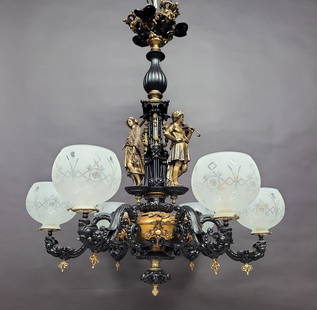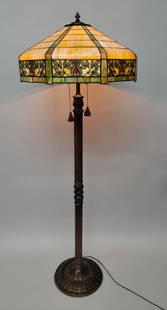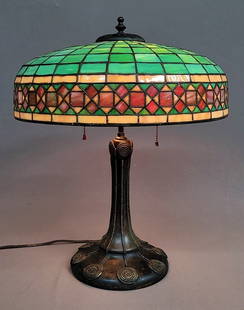
19th C. Russian Gilt Silver Enamel Cloisonne Salt Dish
Similar Sale History
View More Items in Tableware & BarwareRelated Tableware & Barware
More Items in Russian Tableware & Barware
View MoreRecommended Home & Décor
View More





Item Details
Description
Eastern Europe, Russia, ca. 19th century CE. An elegant gilt silver salt cellar with miniature spoon and sparing cloisonne details. The cellar is gilded on the interior and in a ring around the exterior rim; below that is an engraved, repeated motif that looks like hands joined in prayer between trios of red, yellow, and green cloisonne elements. The spoon is gilded silver with a red and green filigree cloisonne pattern on the handle. Size of bowl: 1.5" W x 0.9" H (3.8 cm x 2.3 cm); size of spoon: 2.1" L x 0.6" W (5.3 cm x 1.5 cm)
Both are stamped with an assay value and a maker's mark - the maker's mark looks like "P I O", which may be that of R. Yurasov.
From the mid-19th century to the early 20th, Russian art of all kinds experienced a renaissance that is known as the Silver Age. Russian artisans were inspired by the Gothic, the Moresque, chinoiserie, the Baroque, the Rococo… all ornate styles, replete with scrolling vines and flourishing arches. They combined this with the bright colors and rich ornament of Old Russian applied art to create a unique style of which silver items like this are some of the most enduring.
Silverware was produced mainly in St Petersburg (which had more western European influence and therefore a more European style) and Moscow (where a more pure Old Russian-inspired style came from), but other cities like Kiev, Odessa, and even places as far afield as Archangelsk had silversmiths creating beautiful objects of art. The industry grew quickly, aided by art exhibitions held from the mid-1850s onward and the public excitedly snapped up the beautiful objects they produced. An exhibition in London in 1851 showcasing silver made in Moscow introduced the Old Russian style to western Europe and the renown of Russian silversmiths increased, with firms like Ovchinnikov, Kurlyukov, the Grachev Brothers, and Faberge attaining national and international renown.
Provenance: Ex- Collection of James Farmer, Maryland, collected from major galleries and auction houses between 1995 and 2005
All items legal to buy/sell under U.S. Statute covering cultural patrimony Code 2600, CHAPTER 14, and are guaranteed to be as described or your money back.
A Certificate of Authenticity will accompany all winning bids.
PLEASE NOTE: Due to recent increases of shipments being seized by Australian & German customs (even for items with pre-UNESCO provenance), we will no longer ship most antiquities and ancient Chinese art to Australia & Germany. For categories of items that are acceptable to ship to Australia, please contact us directly or work with your local customs brokerage firm.
#120551
Both are stamped with an assay value and a maker's mark - the maker's mark looks like "P I O", which may be that of R. Yurasov.
From the mid-19th century to the early 20th, Russian art of all kinds experienced a renaissance that is known as the Silver Age. Russian artisans were inspired by the Gothic, the Moresque, chinoiserie, the Baroque, the Rococo… all ornate styles, replete with scrolling vines and flourishing arches. They combined this with the bright colors and rich ornament of Old Russian applied art to create a unique style of which silver items like this are some of the most enduring.
Silverware was produced mainly in St Petersburg (which had more western European influence and therefore a more European style) and Moscow (where a more pure Old Russian-inspired style came from), but other cities like Kiev, Odessa, and even places as far afield as Archangelsk had silversmiths creating beautiful objects of art. The industry grew quickly, aided by art exhibitions held from the mid-1850s onward and the public excitedly snapped up the beautiful objects they produced. An exhibition in London in 1851 showcasing silver made in Moscow introduced the Old Russian style to western Europe and the renown of Russian silversmiths increased, with firms like Ovchinnikov, Kurlyukov, the Grachev Brothers, and Faberge attaining national and international renown.
Provenance: Ex- Collection of James Farmer, Maryland, collected from major galleries and auction houses between 1995 and 2005
All items legal to buy/sell under U.S. Statute covering cultural patrimony Code 2600, CHAPTER 14, and are guaranteed to be as described or your money back.
A Certificate of Authenticity will accompany all winning bids.
PLEASE NOTE: Due to recent increases of shipments being seized by Australian & German customs (even for items with pre-UNESCO provenance), we will no longer ship most antiquities and ancient Chinese art to Australia & Germany. For categories of items that are acceptable to ship to Australia, please contact us directly or work with your local customs brokerage firm.
#120551
Condition
Nice patina. Small losses to the enamel around the bowl edge.
Buyer's Premium
- 24.5%
19th C. Russian Gilt Silver Enamel Cloisonne Salt Dish
Estimate $550 - $825
2 bidders are watching this item.
Shipping & Pickup Options
Item located in Louisville, CO, usSee Policy for Shipping
Payment

TOP


















































































